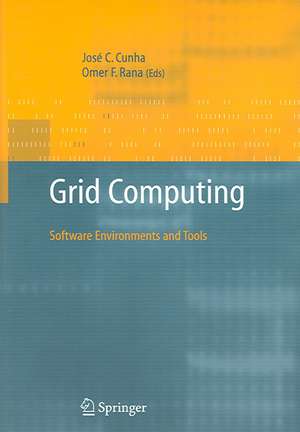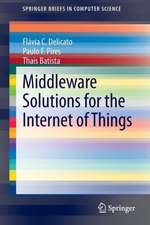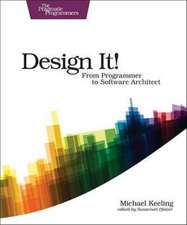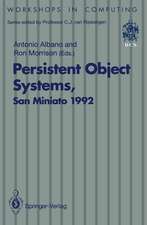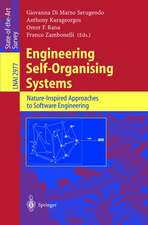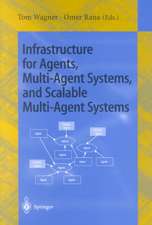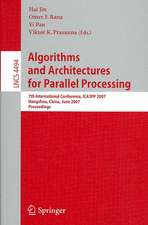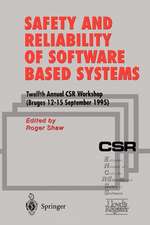Grid Computing: Software Environments and Tools
Editat de Omer F. Rana, Jose Cardoso Cunhaen Limba Engleză Paperback – 20 dec 2005
Specific topics covered include:
- An overview of structural and behavioural properties of Computer Grid applications
- Discussion of alternative programming techniques
- Case studies displaying the potential of Computer Grids in solving real problems
Preț: 652.87 lei
Preț vechi: 816.09 lei
-20% Nou
Puncte Express: 979
Preț estimativ în valută:
124.94€ • 129.96$ • 103.15£
124.94€ • 129.96$ • 103.15£
Carte tipărită la comandă
Livrare economică 14-28 aprilie
Preluare comenzi: 021 569.72.76
Specificații
ISBN-13: 9781852339982
ISBN-10: 1852339985
Pagini: 344
Ilustrații: XIV, 346 p. 140 illus.
Dimensiuni: 178 x 254 x 17 mm
Greutate: 0.62 kg
Ediția:2006
Editura: SPRINGER LONDON
Colecția Springer
Locul publicării:London, United Kingdom
ISBN-10: 1852339985
Pagini: 344
Ilustrații: XIV, 346 p. 140 illus.
Dimensiuni: 178 x 254 x 17 mm
Greutate: 0.62 kg
Ediția:2006
Editura: SPRINGER LONDON
Colecția Springer
Locul publicării:London, United Kingdom
Public țintă
Professional/practitionerDescriere
Grid Computing requires the use of software that can divide and farm out pieces of a program to as many as several thousand computers. This book explores processes and techniques needed to create a successful Grid infrastructure. Leading researchers in Europe and the US look at the development of specialist tools and environments which will encourage the convergence of the parallel programming, distributed computing and data management communities.
Specific topics covered include:
Specific topics covered include:
- An overview of structural and behavioural properties of Computer Grid applications
- Discussion of alternative programming techniques
- Case studies displaying the potential of Computer Grids in solving real problems
Cuprins
Virtualization in Grids: A Semantical Approach.- Virtualization in Grids: A Semantical Approach.- Using Event Models in Grid Design.- Using Event Models in Grid Design.- Intelligent Grids.- Intelligent Grids.- Programming and Process.- A Grid Software Process.- Grid Programming with Java, RMI, and Skeletons.- User Environments and Tools.- A Review of Grid Portal Technology.- A Framework for Loosely Coupled Applications on Grid Environments.- Toward GRIDLE: A Way to Build Grid Applications Searching Through an Ecosystem of Components.- Programming, Composing, Deploying for the Grid.- ASSIST As a Research Framework for High-Performance Grid Programming Environments.- A Visual Programming Environment for Developing Complex Grid Applications.- Applications.- Solving Computationally Intensive Engineering Problems on the Grid Using Problem Solving Environments.- Design Principles for a Grid-enabled Problem-solving Environment to Be Used by Engineers.- Toward the Utilization of Grid Computing in Electronic Learning.
Recenzii
No review will do this book justice. Being in the field of Grid Computing, I know how hard it is to find a text that covers the Software Engineering aspects of Grid without the heavy math presentation and chapters of theory upon theory. There is nothing wrong with theory of Grid Computing, but after reading the basics you need to actually architect and build your applications for Grid. This is the first book that covers Grid Computing from the architects’ perspective – and does so in a practical matter.
This book aims at demonstrating and teaching the difficult task of Software Engineering aspects of Grid Computing. Grid-enabling an application is not like any other methodologies that we have heard before as it requires intimate knowledge of the underlying infrastructure (network, operating system, memory, etc) along with an in-depth knowledge of the application which one is Grid-enabling.
The book targets developers of Grid applications primarily, with a focus on what the authors call "deployment specialists". It focuses on this very aspect of Software Engineering and explores the how-to in order to ensure common understanding of the Grid across the organization.
It is a practical approach to Grid computing and Software Engineering aspect of Grid. The authors take the readers thru a journey of what it means to build a Grid from ground-up: software architecture, infrastructure, development, deployment, monitoring, upgrade, etc… I highly recommend this text to anyone interested in the field of Grid Computing or Software development for Grid environment.
"Art Sedighi"
This book aims at demonstrating and teaching the difficult task of Software Engineering aspects of Grid Computing. Grid-enabling an application is not like any other methodologies that we have heard before as it requires intimate knowledge of the underlying infrastructure (network, operating system, memory, etc) along with an in-depth knowledge of the application which one is Grid-enabling.
The book targets developers of Grid applications primarily, with a focus on what the authors call "deployment specialists". It focuses on this very aspect of Software Engineering and explores the how-to in order to ensure common understanding of the Grid across the organization.
It is a practical approach to Grid computing and Software Engineering aspect of Grid. The authors take the readers thru a journey of what it means to build a Grid from ground-up: software architecture, infrastructure, development, deployment, monitoring, upgrade, etc… I highly recommend this text to anyone interested in the field of Grid Computing or Software development for Grid environment.
"Art Sedighi"
Textul de pe ultima copertă
With the emergence of regional, national and global programmes to establish Grid computing infrastructure, it is important to be able to utilise this infrastructure effectively. Specialist software is therefore necessary to enable the deployment of applications over such Grid infrastructure, and to help software developers construct suitable components.
The uptake of Grid computing technologies will be restricted by the availability of suitable methodologies and tools. The aim of this book is to identify exemplary software engineering techniques for Grid environments, along with specialist tools that encapsulate such techniques. Case studies that illustrate their use are also discussed.
The book provides:
• Discussion of software engineering and modelling tools for the Grid
• Analysis of issues inherent in enabling distributed computing across the Grid
• Consideration of the software engineering support necessary for managing Grid applications
• Proposal of a posited software engineering lifecycle to support application development for Grid Environments (along with associated tools).
• Identification of novel concepts, methods and tools within Grid computing which can be put to work in the context of existing experiments and application case studies
The uptake of Grid computing technologies will be restricted by the availability of suitable methodologies and tools. The aim of this book is to identify exemplary software engineering techniques for Grid environments, along with specialist tools that encapsulate such techniques. Case studies that illustrate their use are also discussed.
The book provides:
• Discussion of software engineering and modelling tools for the Grid
• Analysis of issues inherent in enabling distributed computing across the Grid
• Consideration of the software engineering support necessary for managing Grid applications
• Proposal of a posited software engineering lifecycle to support application development for Grid Environments (along with associated tools).
• Identification of novel concepts, methods and tools within Grid computing which can be put to work in the context of existing experiments and application case studies
Caracteristici
Provides the reader with a clear overview of Computational Grids and new research being undertaken to improve existing approaches
Includes the contributions of leading researchers in Europe and the U.S.
Discusses integration of both high-end resources using OGSA/Globus, and looser peer-to-peer type grids
Case studies illustrate the potential of Computer Grids in solving real problems
Includes the contributions of leading researchers in Europe and the U.S.
Discusses integration of both high-end resources using OGSA/Globus, and looser peer-to-peer type grids
Case studies illustrate the potential of Computer Grids in solving real problems
